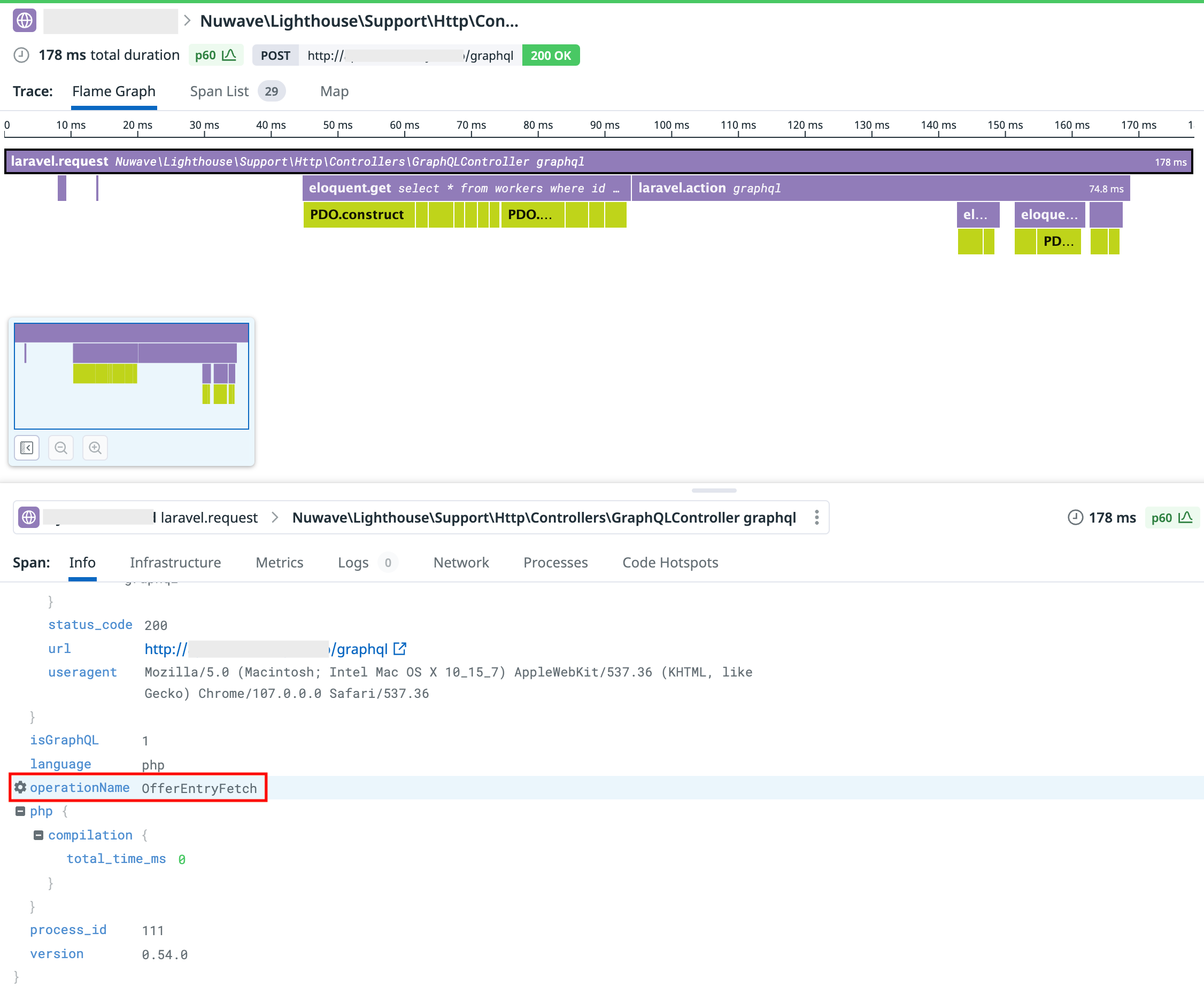この記事はうるる Advent Calendar 2022の1日目の記事です。
はじめに
今回は自分が担当しているプロジェクトのバックエンドで,
GraphQLサーバーとして利用している,
Lighthouse の具体的な利用法について記事を書いていきます!
下記のような方にささればいいな〜と思ってます.
- これからLighthouseを導入するための材料を集めている
- Lighthouseを具体的にどう利用しているのか知りたい
Lighthouse公式ドキュメント
https://lighthouse-php.com/
GraphQLの基本は下記で学びました.
https://www.oreilly.co.jp/books/9784873118932/
各種バージョン
- PHP:8.1
- Laravel:9.0
- lighthouse:5.55
- dd-trace:0.74.0
Lighthouseの導入
下記を参照にどうぞ.
https://lighthouse-php.com/master/getting-started/installation.html#install-via-composer
詳細は割愛します.
スキーマの分割
全てschema.graphqlに記載をまとめることもできますが,
かなり分かりにくくなるので分割します.
ディレクトリ構成
下記のような構成にしてます.
基本modelごとにファイルを分けてます.
src/
├ graphql/
│ ├ models/
│ │ ├ user.graphql
│ │ ├ company.graphql
│ │ ├ ...
│ │ └ prefecture.graphql
│ └ schema.graphql
...
スキーマの書き方
schema.graphql
models配下にあるファイル達を読み込めるようにします.
type Query
type Mutation
#import **/*.graphql
model配下にあるファイル達
extend type Query, extend type Mutationと定義する
extend type Query {
"hugahuga"
hoge: Hoge! @paginate(defaultCount: 10)
}
extend type Mutation {
"hugehuge"
update(id: Int!, input: HugeInput @spread): Huge @update
}
...
クエリ名の枯渇を防ぐ
all や find などの汎用的に使いたいクエリ名ですが,
何も工夫せずにスキーマを組み立てると一度きりしか使えなくなってしまいます.
名前を変えて回避するにも,
userAll や companyAll などになってしまうのでいまいちです.
userのallクエリ, companyのallクエリといった感じの方が使いやすいです.
なので typeにクエリを指定できるようにして 業務ごとのクエリをまとめていくことで回避します.
何もしないリゾルバを用意
空配列を返すNoopリゾルバを用意します
<?php
namespace Modules\GraphQL\Queries;
/**
* Class NoopResolver
*/
class NoopResolver
{
/**
*
* @param null $_
* @param array<string, mixed> $args
*/
public function __invoke($_, array $args): array
{
return [];
}
}
NoopResolverを用いてスキーマの定義を行う
- @field関数にて定義したNoopResolverを利用.
- クエリをまとめるtypeを用意する
- フィールド定義するtypeを定義する
extend type Query {
"【Query】ユーザー"
user: UserQuery! @field(resolver: "NoopResolver")
}
"【Type】ユーザー"
type User {
"ID"
id: Int!
"名前"
name: String!
"有効フラグ"
active: Boolean!
"作成日時"
createdAt: DateTime @rename(attribute: "created_at")
"更新日時"
updatedAt: DateTime @rename(attribute: "updated_at")
}
"【Query】ユーザー"
type UserQuery {
"ユーザー全件取得"
all: [User!]! @paginate(defaultCount: 10)
}
extend type Query {
"【Query】会社"
company: CompanyQuery! @field(resolver: "NoopResolver")
}
"【Type】会社"
type Company {
"ID"
id: Int!
"名前"
name: String!
"住所"
address: String!
"作成日時"
createdAt: DateTime @rename(attribute: "created_at")
"更新日時"
updatedAt: DateTime @rename(attribute: "updated_at")
}
"【Query】会社"
type CompanyQuery {
"会社全件取得"
all: [Company!]! @paginate(defaultCount: 10)
}
これにより下記のようにallクエリが衝突せずに呼べるようになります.
{
user {
all {
data {
id
name
}
}
}
company {
all {
data {
id
name
}
}
}
}
よく使うDirectiveや記述方法3選
頻繁に利用する3選をお送りします.
Local Scopes
公式は下記.
https://lighthouse-php.com/5/eloquent/getting-started.html#local-scopes
対象モデルで特定データの絞り込みを行いたい時に利用する.
リレーション先のデータを絞り込んで抽出する時に重宝する.
使い方
ユーザーの中でもアクティブなユーザーとアクティブでないユーザーで出しわけしたいケースで使ってみる.
modelにscopeから始まる関数を定義し, 中の処理でクエリを書く.
<?php
...省略
class User
{
...省略
/**
* @param Builder $query
*
* @return Builder
*/
public function scopeActive(Builder $query): Builder
{
return $query->where('active', true);
}
/**
* @param Builder $query
*
* @return Builder
*/
public function scopeInActive(Builder $query): Builder
{
return $query->where('active', false);
}
}
スキーマで利用しているallディレクティブにscopesを定義する.
extend type Query {
"【Query】ユーザー"
user: UserQuery! @field(resolver: "NoopResolver")
}
"【Type】ユーザー"
type User {
"ID"
id: Int!
"アクティブフラグ"
active: Boolean!
"名前"
name: String!
}
"【Query】ユーザー"
type UserQuery {
"アクティブユーザー取得"
allActiveUser: [User!]! @all(scopes: ["active"])
"非アクティブユーザー取得"
allInActiveUser: [User!]! @all(scopes: ["inActive"])
}
下記クエリで各種データを取得できる
{
user {
allActiveUser {
data {
id
active
name
}
}
allInActiveUser {
data {
id
active
name
}
}
}
}
@method
抽出するデータ毎に,
計算結果などのフィールドを追加したい場合に利用.
公式ドキュメント
https://lighthouse-php.com/5/api-reference/directives.html#method
使い方
簡単な例として,
アクティブ状態によって返す文言が変わるフィールドを追加してみる.
modelに関数を定義する
... 省略
/**
* @return string
*/
public function isActive(): string
{
if ($this->active) {
return 'アクティブ';
}
return '非アクティブ';
}
フィールドに追加する
extend type Query {
"【Query】ユーザー"
user: UserQuery! @field(resolver: "NoopResolver")
}
"【Type】ユーザー"
type User {
"ID"
id: Int!
"アクティブ文言"
isActive: String! @method(name: "isActive")
"名前"
name: String!
}
"【Query】ユーザー"
type UserQuery {
"ユーザー全件取得"
all: [User!]! @all
}
@hasManyディレクティブのrelationを活用
ケースとして,
リレーション先のデータをscopesで絞り込みつつ,
フィールド名を変えていきたい場合に利用する.
使い方
companyが保持するuserで,
アクティブなuserと非アクティブなユーザーで出し分けてみる.
companyのmodelにリレーションを定義する.
... 省略
/**
* @return HasMany
*/
public function users(): HasMany
{
return $this->hasMany(User::class);
}
usrのmodelにscopeを定義する.(前の章で定義した内容と同じです)
...省略
/**
* @param Builder $query
*
* @return Builder
*/
public function scopeActive(Builder $query): Builder
{
return $query->where('active', true);
}
/**
* @param Builder $query
*
* @return Builder
*/
public function scopeInActive(Builder $query): Builder
{
return $query->where('active', false);
}
}
フィールドを定義する.
Lighthouseの特性上,
フィールド名がリレーションの関数名と等しいとみなすので,
relationオプションを用いて, 直接関数名を指定する必要がある.
extend type Query {
"【Query】会社"
company: CompanyQuery! @field(resolver: "NoopResolver")
}
"【Type】会社"
type Company {
"ID"
id: Int!
"名前"
name: String!
"住所"
address: String!
"作成日時"
createdAt: DateTime @rename(attribute: "created_at")
"更新日時"
updatedAt: DateTime @rename(attribute: "updated_at")
"アクティブなユーザー"
activeUsers: [User!]! @hasMany(scopes: ["active"], relation: "users")
"非アクティブなユーザー"
inActiveUsers: [User!]! @hasMany(scopes: ["inActive"], relation: "users")
}
"【Query】会社"
type CompanyQuery {
"会社全件取得"
all: [Company!]! @paginate(defaultCount: 10)
}
クエリのパフォーマンスを計測したい
GraphQLはエンドポイントが1つになるため,
パフォーマンスが計測しにくい.
私たちはDatadogのAPMにタグ付けして連携することで,
クエリごとに集計ができるようにしています.
やりかた
DatadogAPMの連携については下記を参照.
詳細は割愛します.
https://docs.datadoghq.com/ja/tracing/trace_collection/dd_libraries/php/?tab=%E3%82%B3%E3%83%B3%E3%83%86%E3%83%8A
src/app/Http/Middleware に Datadog.php を作成.
クエリを叩いた時のRequestからoperationNameを取得し, タグ付けする.
<?php
namespace App\Http\Middleware;
use Closure;
use Illuminate\Http\Request;
use DDTrace\GlobalTracer;
class Datadog
{
/**
* @return mixed
*/
public function handle(Request $request, Closure $next)
{
$response = $next($request);
$span = GlobalTracer::get()->getActiveSpan();
if ($span === null) {
return $response;
}
$operationName = $request->toArray();
if ($operationName) {
$span->setTag('operationName', $operationName["operationName"]);
}
return $response;
}
}
src/config/lighthouse.php の$middlewareに上記で作成したClassを突っ込む.
<?php
$middleware = [
...省略
\App\Http\Middleware\Datadog::class
];
OperationNameを付与し, クエリを叩くとDatadogAPMにデータが連携される.

さいごに
Lighthouseかなりいいです...!
チームでかなり検証しましたが,
便利なディレクティブも豊富で, 読み込みでやりたいことはほとんどできました.
N+1問題もよしなに解決してくれますし.
https://lighthouse-php.com/master/performance/n-plus-one.html#the-n-1-query-problem
紹介できていない部分もかなりありますが,
LaravelでGraphQLサーバーかまえたい方にはおすすめです!
明日は, kurifumi さんによる記事です!
ご期待ください!